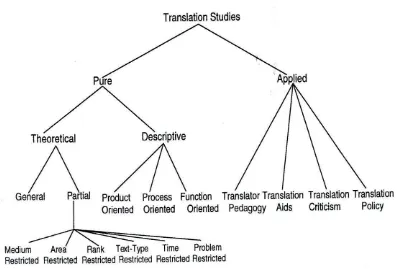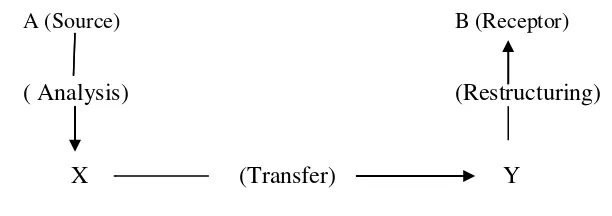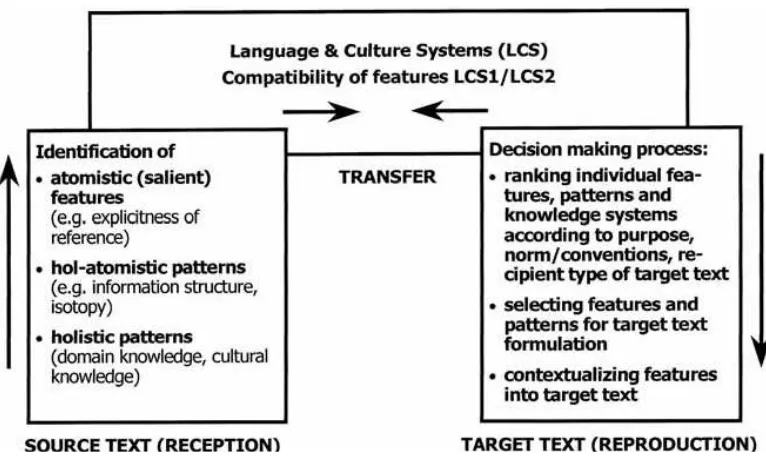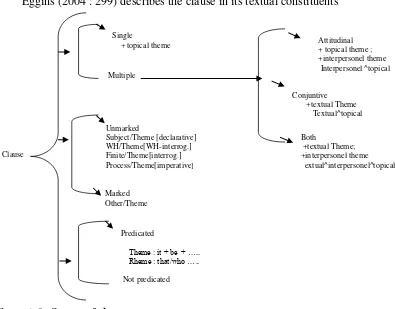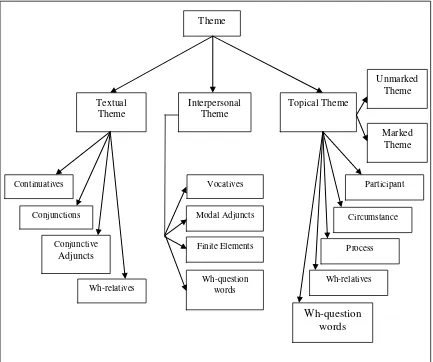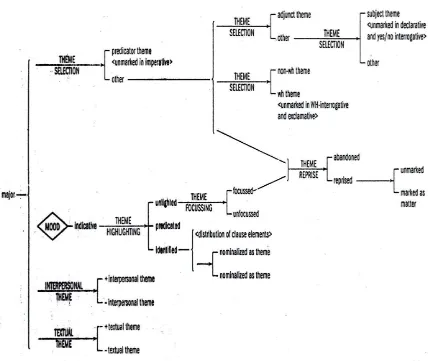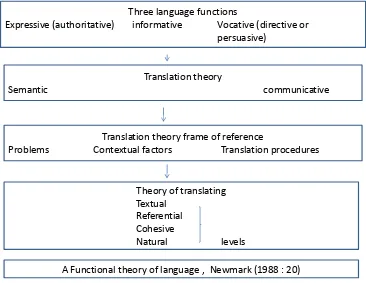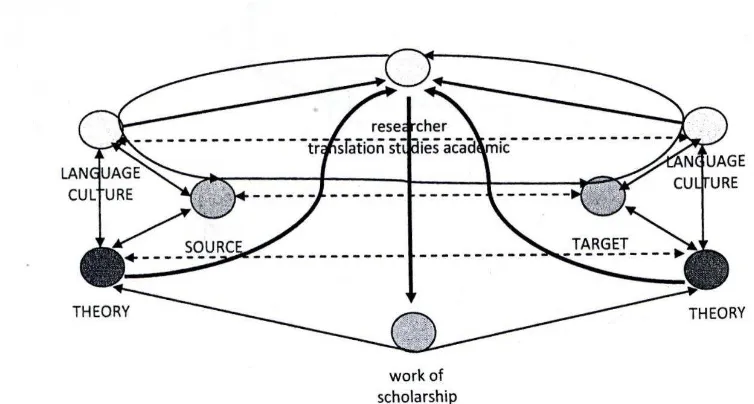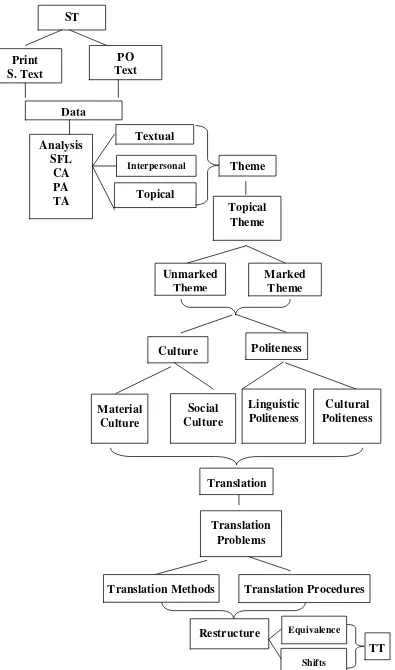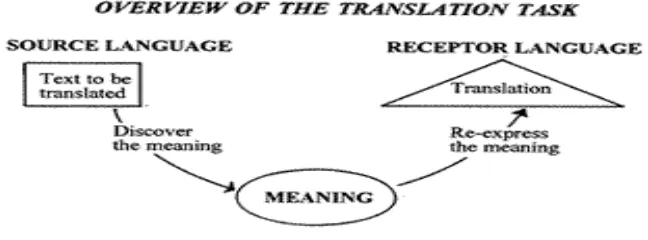TRANSLATING THEMES OF REBU TEXTS IN
KARONESE SOCIETY INTO ENGLISH
A DISSERTATION
By
MILISI SEMBIRING
Reg. Number 098107011
Doctor Program (S3) Linguistics
.
FACULTY OF CULTURAL SCIENCES
UNIVERSITY OF SUMATERA UTARA
TRANSLATING THEMES OF REBU TEXTS IN
KARONESE SOCIETY INTO ENGLISH
A DISSERTATION
Submitted to the Postgraduate Studies of Linguistics, Faculty of Cultural Sciences, University of Sumatera Utara, in Partial Fulfillment of the Requirements for
the Degree of Doctor in Linguistics under the Authority of the Rector Prof. Dr. dr. Syahril Pasaribu, DTM&H., M.Sc. (CTM)., Sp.A(K).
By
MILISI SEMBIRING
Reg. Number 098107011
Doctor Program (S3) Linguistics
FACULTY OF CULTURAL SCIENCES
UNIVERSITY OF SUMATERA UTARA
Title of the Dissertation :Translating Themes of Rebu Texts in
Karonese Society into English
Name of the Student : Milisi Sembiring Reg. Number : 098107011 Study Program : Linguistics
Approved and Accepted by Promotor Commision
Prof. Dr. Busmin Gurning, M.Pd Promotor
Dr. Syahron Lubis, MA Dr. Matius C.A Sembiring, M.A
Co-Promotor Co-Promotor
Chairperson of Linguistics Study Program Dean of Cultural Science Faculty
THE RESULT OF THIS DISSERTATION RESEARCH HAS BEEN APPROVED BY THE FINAL EXAMINING COMMITTEE AND ACCEPTED BY LINGUISTICS STUDY PROGRAM OF THE FACULTY
OF CULTURAL SCIENCES OF THE UNIVERSITY OF SUMATERA UTARA
FOR THE PROMOTION
Approved by Promotor
Prof. Dr. Busmin Gurning, M.Pd
Co-Promotors
Dr. Syahron Lubis, MA Dr. Matius C.A Sembiring, M.A
Legalized
Chairperson of Linguistics Study Program
The Faculty of Cultural Sciences of the University of Sumatera Utara
Examined in the Promotion
EXAMINATION COMMITTEE
Chairperson : Prof. Dr. Busmin Gurning, M.Pd
Members : 1. Dr. Syahron Lubis, MA
2. Dr. Matius C.A Sembiring, M.A
3. Prof. T. Silvana Sinar, MA.,Ph.D
4. Assoc. Prof. Hasuria Che Omar, M.A, Ph.D
5. Dr. Eddy Setia, M.Ed. TESP
With the Rector Decree of the University of Sumatera Utara Number :02/UN5.1.R/SK/SSA/2014
Date : January 4, 2014
TEAM OF PROMOTORS
Prof. Dr. Busmin Gurning, M.Pd
Dr. Syahron Lubis, MA
BOARD OF EXAMINERS
Prof. T. Silvana Sinar, MA.,Ph.D
Assoc. Prof. Hasuria Che Omar, M.A, Ph.D
Dr. Eddy Setia, M.Ed. TESP
First examination (closed) December 16, 2013
Examination Committee
Chairperson : Prof. Dr. Busmin Gurning, M.Pd Unimed Medan
Members : 1. Dr. Syahron Lubis, MA USU Medan
2. Dr. Matius C.A Sembiring, M.A USU Medan
3. Prof. T. Silvana Sinar, MA.,Ph.D USU Medan
4. Assoc. Prof. Hasuria Che Omar, M.A, Ph.D USM Penang
5. Dr. Eddy Setia, M.Ed. TESP USU Medan
6. Dr. Roswita Silalahi, Dip. TESOL, M.Hum USU Medan
Rector’s Decree
Number :1591/UN5.1R/SK/SSA/2013
Second examination (Promotion) January 29, 2014
Examination Committee
Chairperson : Prof. Dr. Busmin Gurning, M.Pd Unimed Medan
Members : 1. Dr. Syahron Lubis, MA USU Medan
2. Dr. Matius C.A Sembiring, M.A USU Medan
3. Prof. T. Silvana Sinar, MA.,Ph.D USU Medan
4. Assoc. Prof. Hasuria Che Omar, M.A, Ph.D USM Penang
5. Dr. Eddy Setia, M.Ed. TESP USU Medan
6. Dr. Roswita Silalahi, Dip. TESOL, M.Hum USU Medan
Rector’s Decree
CERTIFICATION
The title of the dissertation
TRANSLATING THEMES OF REBU TEXTS IN
KARONESE SOCIETY INTO ENGLISH
I certify that the dissertation I wrote as one of the requirements to obtain the degree of Doctor from the Study Program of Linguistics, the Faculty of Cultural Science of the University of Sumatera Utara is exactly my own work.
I certify that I clearly mention the references of the citations I use in some specific parts of this dissertation base on the norm, rule, and etiquette of the technique of the scientific writing.
I certify, in the future, that I am willing to accept the sanction of revocation of my academic degree which I received and other sanctions in accordance with the applicable rules and laws, provided some parts or all of this dissertation are invented not my own work or to commit plagiarism.
Medan, January 29, 2014
ABSTRACT
The aims of this study are to find out the translation of themes of rebu clauses, politeness and specific culture- bound terms in source language into the target language and to analyze them systematically.
This study is also aimed at identifying the problems arising while translating source language into target language and applied the translation methods and procedures to resolve the problems. The Karonese language of Singalorlau region is chosen as the focus of participation observation. The data of this study are cultural texts in Karonese society and the data are purposively selected. The research is conducted using the qualitative method. The data obtained is analyzed by using interdiciplinary approach. The data for this study consists of three texts, the first text is the text of mukul which consists of the beginning of rebu in a Karonese family. The second text consists of rebu in Karonese society and kinds of rebu. Thirdly is the text of participation observation. Rebu clauses are analyzed and described regarding to each category. All 121 clauses are translated and examined in this study. The overall areas of analysis are carried out, representing Halliday’s three metafunctions: the ideational, the interpersonal and the textual. The focus of the analysis is the ideational or topical themes of rebu texts. Newmark’s model of translation methods and translation procedures are selected to resolve the problems to translate the themes of rebu clauses and the specific culture bound terms in the source language. Four models of analysis are used to interpret the results ; systemic functional linguistics, cultural, politeness and translation analyses are applied to translate rebu texts in Karonese society. The themes, culture-bound terms and politeness problems arising while translating source text into target text are identified to be the center of the analysis. The systemic functional linguistics analysis of the topical themes in source language show the themes in declarative and non declarative sentences. Overall, the results certain marked and unmarked themes , specific bound culture terms and politeness are the constraints in the process of translation. The translation methods and procedures are applied to resolve these problems. The results reveal two translation methods and seven translation procedures are applied in translating the themes of rebu texts in Karonese society. They are literal and semantic translation methods. For the translation procedures, they are descriptive equivalence, transference, paraphrase, transposition/shift, couplets , notes and cultural equivalence.
ABSTRAK
Tujuan dari penelitian ini adalah untuk memperoleh penerjemahan tema, istilah-istilah budaya yang spesifik dan kesopan-santunan pada klausa rebu dari bahasa sumber ke bahasa Inggeris serta menganalisisnya secara sistematis. Tujuan lain penelitian ini adalah untuk mengidentifikasi masalah yang muncul saat menerjemahkan bahasa sumber ke bahasa sasaran, sekaligus menerapkan metode dan prosedur penerjemahan untuk menyelesaikan masalah tersebut. Bahasa Karo Singalorlau dipilih sebagai fokus observasi partisipatif. Data penelitian ini adalah teks budaya dalam masyarakat Karo dan data dipilih sesuai dengan kecukupan maupun cakupannya. Penelitian ini dilakukan dengan menggunakan metode kualitatif, kemudian data yang diperoleh dianalisis secara pendekatan interdisipliner. Ada tiga teks data penelitian ini yaitu pertama teks mukul, awal rebu dalam suatu keluarga masyarakat Karo. Teks kedua terdiri dari rebu dan jenis rebu dalam masyarakat Karo, sedangkan yang ketiga merupakan teks observasi partisipatif. Klausa rebu dianalisis sekaligus dijelaskan sesuai masing-masing kategori. Ada 121 klausa yang diterjemahkan dan diteliti dalam penelitian ini. Keseluruhan analisis dilakukan, mengacu pada tiga metafungsi Halliday yaitu: tema ideasional, interpersonal serta tekstual. Analisis berfokus pada tema ideasional atau topikal teks rebu. Prosedur penerjemahan model Newmark, dipilih untuk menyelesaikan masalah dalam menerjemahkan tema dari klausa teks rebu serta budaya yang ada pada teks rebu dalam bahasa sumber. Ada empat model analisis yang digunakan untuk menginterpretasikan hasil penelitian ini, yaitu analisis linguistik sistemik funsional , cultural analysis, politeness analysis serta translation analysis yang diterapkan untuk menerjemahkan teks rebu dalam masyarakat Karo ke dalam bahasa Inggris. Secara keseluruhan, dalam proses penerjemahan ditemukan masalah penerjemahan berupa tema tidak lazim, tema lazim, istilah budaya yang spesifik dan kesopan santunan yang merupakan fokus analisis pada penelitian ini.Analisis secara linguistik sistemik funfsional terhadap tema topical pada bahasa sumber menunjukkan tema pada kalimat deklaratif dan non-deklaratif.Secara keseluruhan, tema lazim, tema tidak lazim, istilah budaya yang spesifik adalah merupakan hambatan dalam proses penerjemahan ini.Metode and prosedur penerjemahan digunakan untuk mengatasi masalah tersebut.Hasil penelitian menunjukkan dua metode penerjemahan dan tujuh prosedur penerjemahan digunakan dalam penerjemahan tema teks rebu dalam bahasa sumber ke bahasa sasaran. Kedua metode penerjemahan tersebut adalah metode penerjemahan harafiah dan semantik. Ke tujuh prosedur penerjemahan yang digunakan adalah descriptive equivalence, transference, paraphrase, transposition/shift, couplets , notes serta cultural equivalence.
ACKNOWLEDGEMENTS
The idea of conducting a dissertation research on translating rebu texts in Karonese society into English came to the researcher’s mind three years ago when
he was presenting a paper in International Conference on Translation and
Multiculturalism held by University of Malay in Kuala Lumpur, Malaysia. The
title of his paper was Translating rebu in Karo Society into English : Problems
and Procedures, which was funded by The Directorate General of Higher
Education (Dikti) on the program of Bantuan Seminar Luar Negeri Tahun 2010.
The insightful advice was given by Prof. Roger T. Bell, PhD, who was his
translation lecturer.
The researcher’s deepest thanks go to the rector of the University of
Sumatera Utara, Prof. Dr. dr. Syahril Pasaribu, DTM&H., M.Sc. (CTM)., Sp.A(K)
who provided him the opportunity to continue his study at the Linguistics Study
Program, Faculty of Cultural Sciences, University of Sumatra Utara (USU).
During the dissertation research at the Linguistics Study Program, Faculty of
Cultural Sciences, Postgraduate Studies at the University of Sumatra Utara
(USU), Medan, he has really been fortunate to have Prof. Dr. Busmin Gurning,
MPd as his promotor, who wisely counseled him not to attempt a broader
analysis of all aspects of the data from multiple source texts, but limit himself to
analyze several representative strong data. On this occasion the researcher would
like to express his sincerest gratitude to his promotor Prof. Dr. Busmin Gurning,
MPd who gave him guidance to do the research in detailed, critical, and deeply
insightful and the co-promotors of this dissertation Dr. Syahron Lubis, MA for
researcher’s work and Dr. Matius CA Sembiring, MA who also suggested him to
read articles on translating cultures in addition to the translation studies books.
The articles on translating cultures provided him important information to resolve
the problems in his dissertation research.
His truthfully gratefulness also given to Dr. Syahron Lubis, MA, as the
Dean of Cultural Science Faculty of Graduate Program of University of Sumatera
Utara, Medan, thanks for his invaluable guidance both in academic and
administrative matters.
. Furthermore, he also indebted to his board examiners Prof. T. Silvana
Sinar, MA, Ph.D, Assoc. Prof. Hasuria Che Omar, PhD, Dr. Eddy Setia, M.Ed.
TESP, and Dr. Roswita Silalahi, Dip. TESOL, M. Hum for their constructive
comments and suggestions in enriching the quality of this dissertation.
The Linguistics Study Program, Faculty of Cultural Sciences, University of
Sumatra Utara is a good place for a PhD student studying, and he would like to
thank all the other the linguistics department members with whom he has had the
opportunity to interact in the last four years.
The researcher is deeply indebted to the chairperson of Linguistics Study
Program, Postgraduate Studies, University of Sumatra Utara Medan, to Prof.
Tengku Silvana Sinar, MA, Ph.D for her contribution of knowledge, time,
encouragement, including the arrangement of the Sandwich-like Program 2011,
he attended at the Hong Kong Polytechnic University , Hong Kong.
He would like to express his gratitude to the following people, who have
provided so much help and support during his Sandwich-like Program 2011:
Prof. Christian M.I.M. Matthiessen Phil.Cand., MA, PhD as the researcher’s
researcher’s Sandwich-like Program and taught him Systemic Functional
Linguistics. Assoc. Prof. Stephen Evans, BA, MA, PGCE, PhD who taught him
Writing Researach Articles at Hong Kong Polytecnic University.
His special thanks also go to PhD research students namely Miss Nancy
Guo, Mr Winfred Xuen and Constance for their perceptive discussion and
comments, and for helping make his stays at Hong Kong Polytecnic University
that much more pleasant. Carmen Tsang, Administrative Manager, Department of
English The Hong Kong Polytechnic University who spent a lot of time to arrange
the schedule of his sandwich-like program.
He is also grateful to Dr. Ali R. Al-Hassnawi, Assoc. Prof. of Linguistics &
Translation, Director of Centre of Foundation Studies in Al Buraimi, Sultanate of
Oman who encouraged and inspired him considerably to do this study.
BPPS (Beasiswa Program Pasca Sarjana) has enabled the researcher to study
at the Postgraduate Studies of Linguistics, Faculty of Cultural Sciences,
University of Sumatra Utara for granting him the three-year studentship.
He would like to express his sincere thanks to Direktorat Diktendik
members for giving him financial Dana Bantuan Penyelesaian Studi Program
Doktor in 2012.
The researcher also feels really grateful to the members of committee of
Penelitian Disertasi Doktor Tahun 2013 who gave him financial support to finish
his dissertation.
A special word of gratitude also goes to Drs. Paham Ginting, M.Hum for
editing the Karonese language of the manuscript and to Ms Wendy Lewis of
to Basmi Sembiring and Usaha Tarigan, the Karonese Adat experts for their
information, particularly for their explanation concerning Karonese culture.
Finally, he also wants to thank his wife, Surita Br Ginting, SKM, M.Kes
who usually encourages , loves and helps him so much to finish his study. His
children – Sri Martha Hizkhi Br Sembiring, SE, Samuel Pola Karta Sembiring and
Endang Yoanna Br Sembiring who inspired and fully supported him in every trial
that came his way.
The researcher realizes that this dissertation still has many weaknesses and
it is far from being perfect, but hopefully this dissertation has benefits for all
readers. May God Almighty bless us all. Amen.
Medan, January 29, 2014
CURRICULUM VITAE
Milisi Sembiring was born in Kuta Buara, on June 13, 1960. He is the first son of his late father, Tammat Sembiring and his mother Terima br Karo. He is a lecturer at Universitas Quality, Medan and regular visiting lecturer for Translation and Language Research at Darma Agung University, Medan and he teaches Syntax at Islamic University of Sumatera Utara , Medan and English at Nursing Academy at Herna Hospital.
He did his BA at University of Sumatera Utara, Medan and his MA at University of Gadjah Mada, Yogyakarta . He is a PhD student of University of Sumatera Utara concentrating on translation.
In 2004, he was awarded Dosen Teladan (1st Model Lecturer) of Universitas Karo, Kabanjahe. At the same year he was also awarded as Dosen Berprestasi Harapan II, Kopertis Wilayah I in 2004.
After studying at University of Sumatera Utara for two semesters, he was a paper presenter in International Conference on Translation and Multiculturalism held by University of Malay in Kuala Lumpur, Malaysia, 23-25 July 2010. The title of his paper was Translating rebu in Karo Society into English : Problems and Procedures, which was funded by The Directorate General of Higher Education (Dikti) on the program of Bantuan Seminar Luar Negeri Tahun 2010.
He attended Sandwich – like Program 2011 in Hong Kong Polytechnic University, Hong Kong. His recent publication is : Translating Rebu in Karonese Society into English Published in IOSR Journal of Humanities and Social Science Vol. 17, Issue 1, November -December 2013.
He has been as a member of Association of Indonesian Translators since 2013. He has just finished his research “Penelitian Disertasi Doktor, 2013” supported by Dikti. Its title is “ Translating Daliken si telu in Karonese Society into English” .
LIST OF FIGURES
Page
Figure 2.1 : Holmes’s and Toury’s conception of translation studies 12
Figure 2.2 : Translation process 16
Figure 2.3 : Arbogast’s phases ofTranslation Process (LCS =
Language and Cultural 17
Figure 2.4 : The flattened V diagram 18
Figure 2.5 : System of Theme 19
Figure 2.6 : Halliday’s model figure of theme 21
Figure 2.7 : Halliday’s system of themes. 23
Figure 2.8 : A functional theory of language 28 Figure 2.9 : Fawcett, Garcia and Parker ‘s figure of translation 39 Figure 2.10 : Framework of translating SL into TL 46 Figure 3.1 : Larson ‘s (1998) diagram of translation process 50
Figure 3.2 : Text sources relationship 51
Figure 3.3 : Components of data Analysis : interactive model 57 Figure 4.1 : Perkade-kaden 12 in Karonesesociety 77
LIST OF TABLES
Page
Table 2.1 : The relationships of register variables and meanings 37
Table 3.1 : Data selection 62 Table 4.12 : Imperative politeness in Karonesesociety 107 Table 5.1 : Overall distribution of themes in the data of 176
Karonese language
Table 5.2 : Overall distribution of themes in the data of English 177 Table 5.3 : Halliday’s model analysis of theme in declarative
clauses in Karonese language 179
Table 5.4 : Halliday’s model analysis of theme in declarative
clauses in English 180
Table 5.5 : The unmarked themes of SL in declarative clause, a polar 183 interrogative clause, WH-element in a WH-interrogative, imperative and, dependent clause.
Table 5.6 : The unmarked themes of TL in declarative clause, a polar 184 interrogative clause, WH-element in a WH-interrogative , imperative, and dependent clause.
Table 5.7 : Karonese specific cultural bound terms ……… 188 Table 5.8 : Social culture in Karonese society……… 193 Table 5.9 : Material culture in Karonesesociety 199 Table 5.10 : The linguistic politeness in Karonese language 202 Table 5.11 : The differences between the Linguistic politeness 224
in SL and TL
List of Abbreviations
DTS = Descriptive Translation Studies
HF = husband’s father
HFSH = husband’s father’s sister’s husband
IT = interpersonal theme
MMBSW. = mother’s mother’s brother’s son’s wife
MMBD = mother’s mother’s brother’s daughter
wife’s mother’s mother’s brother’s sister
WMBW = wife’s mother’s brother’s wife
WFBW = wife’s father’s brother’s wife
ZDH = sister’s daughter’s husband
MAP
Page
LIST OF PICTURES
Page 1. Appendix 6 : Picture of Traditional Karonese house…. 25
TABLE OF CONTENTS
1.5 The Significance of the Study…… 8
1.6 Definition of Key Terms ……… 9
CHAPTER II : REVIEW OF LITERATURE 11
2.1 Translation ………. 11
2.2 Contribution of SFL to Translation…… 18
2.3 Functions of Language……….. 28
2.4 Ideology in Translation……….. 29
2.5 Methods of Translation……… 29
2.6 Procedures of Translation 31
2.7 Translation Techniques ………… 34
2.8 Politeness Strategies……… 40
2.9 Previous Studies on the English Translation of RebuTexts in Karonese Society…… 41 2.10 Conceptual Framework for Translating
3.4 The Technique of Collecting the Data … 55
3.5 Data Analysis ………. 57
3.6 Methods for Verification or Trustworthiness 61
3.7 Selecting Source Texts ……… 62
CHAPTER IV : KARONESE SOCIETY 70
4.1 KaroneseCulture ……… 70
4.1.2 Kinship Terms in Karonese Society 76 4.1.3 Marriage in Karonese Society ….. 80 4.1.3.1The steps of wedding ceremony in
Karonese society …….. 81
4.1.3.2 The phase in maba belo selambar 82 4.1.4 Daliken si Telu/Rakut si Telu 84 4.1.4.1 Categories of kalimbubu…… 85 4.1.4.2 Categories of senina/sembuyak 86 4.1.4.3 Categories of anakberu 86
4.1.5 Tutur Siwaluh ……… 87
4.1.6 Orat Tutur Merga Silima……… 88
4.2 Karonese Language ……… 89
4.2.1 Pronouns in Karonese Language …….. 90 4.2.2 Interrogative Sentences in Karonese 5.2.6 Translation Methods and Procedures 221
Used in Translating Problems in Rebu
7.3 Implication of the Study.. 247
REFERRENCES ……… 1
APPENDICES ……… 1
Appendix 1 : Text of Mukul / mecah-mecah tinaroh/
persadaan tendi, (Ginting, 2008)……….. 1 Appendix 2 : Text of Rebu Pada Masyarakat Karo,
(Tarigan, 1988)………. 5 Appendix 3 : Text of Data Participation Observations………… 10 Appendix 4 : Data of the overall texts ………. 12
Appendix 5 : Letter of recommendations……….. 21
Appendix 6 : Picture of Traditional House……… 25 Appendix 7 : Picture of mukul……… 25
ABSTRACT
The aims of this study are to find out the translation of themes of rebu clauses, politeness and specific culture- bound terms in source language into the target language and to analyze them systematically.
This study is also aimed at identifying the problems arising while translating source language into target language and applied the translation methods and procedures to resolve the problems. The Karonese language of Singalorlau region is chosen as the focus of participation observation. The data of this study are cultural texts in Karonese society and the data are purposively selected. The research is conducted using the qualitative method. The data obtained is analyzed by using interdiciplinary approach. The data for this study consists of three texts, the first text is the text of mukul which consists of the beginning of rebu in a Karonese family. The second text consists of rebu in Karonese society and kinds of rebu. Thirdly is the text of participation observation. Rebu clauses are analyzed and described regarding to each category. All 121 clauses are translated and examined in this study. The overall areas of analysis are carried out, representing Halliday’s three metafunctions: the ideational, the interpersonal and the textual. The focus of the analysis is the ideational or topical themes of rebu texts. Newmark’s model of translation methods and translation procedures are selected to resolve the problems to translate the themes of rebu clauses and the specific culture bound terms in the source language. Four models of analysis are used to interpret the results ; systemic functional linguistics, cultural, politeness and translation analyses are applied to translate rebu texts in Karonese society. The themes, culture-bound terms and politeness problems arising while translating source text into target text are identified to be the center of the analysis. The systemic functional linguistics analysis of the topical themes in source language show the themes in declarative and non declarative sentences. Overall, the results certain marked and unmarked themes , specific bound culture terms and politeness are the constraints in the process of translation. The translation methods and procedures are applied to resolve these problems. The results reveal two translation methods and seven translation procedures are applied in translating the themes of rebu texts in Karonese society. They are literal and semantic translation methods. For the translation procedures, they are descriptive equivalence, transference, paraphrase, transposition/shift, couplets , notes and cultural equivalence.
ABSTRAK
Tujuan dari penelitian ini adalah untuk memperoleh penerjemahan tema, istilah-istilah budaya yang spesifik dan kesopan-santunan pada klausa rebu dari bahasa sumber ke bahasa Inggeris serta menganalisisnya secara sistematis. Tujuan lain penelitian ini adalah untuk mengidentifikasi masalah yang muncul saat menerjemahkan bahasa sumber ke bahasa sasaran, sekaligus menerapkan metode dan prosedur penerjemahan untuk menyelesaikan masalah tersebut. Bahasa Karo Singalorlau dipilih sebagai fokus observasi partisipatif. Data penelitian ini adalah teks budaya dalam masyarakat Karo dan data dipilih sesuai dengan kecukupan maupun cakupannya. Penelitian ini dilakukan dengan menggunakan metode kualitatif, kemudian data yang diperoleh dianalisis secara pendekatan interdisipliner. Ada tiga teks data penelitian ini yaitu pertama teks mukul, awal rebu dalam suatu keluarga masyarakat Karo. Teks kedua terdiri dari rebu dan jenis rebu dalam masyarakat Karo, sedangkan yang ketiga merupakan teks observasi partisipatif. Klausa rebu dianalisis sekaligus dijelaskan sesuai masing-masing kategori. Ada 121 klausa yang diterjemahkan dan diteliti dalam penelitian ini. Keseluruhan analisis dilakukan, mengacu pada tiga metafungsi Halliday yaitu: tema ideasional, interpersonal serta tekstual. Analisis berfokus pada tema ideasional atau topikal teks rebu. Prosedur penerjemahan model Newmark, dipilih untuk menyelesaikan masalah dalam menerjemahkan tema dari klausa teks rebu serta budaya yang ada pada teks rebu dalam bahasa sumber. Ada empat model analisis yang digunakan untuk menginterpretasikan hasil penelitian ini, yaitu analisis linguistik sistemik funsional , cultural analysis, politeness analysis serta translation analysis yang diterapkan untuk menerjemahkan teks rebu dalam masyarakat Karo ke dalam bahasa Inggris. Secara keseluruhan, dalam proses penerjemahan ditemukan masalah penerjemahan berupa tema tidak lazim, tema lazim, istilah budaya yang spesifik dan kesopan santunan yang merupakan fokus analisis pada penelitian ini.Analisis secara linguistik sistemik funfsional terhadap tema topical pada bahasa sumber menunjukkan tema pada kalimat deklaratif dan non-deklaratif.Secara keseluruhan, tema lazim, tema tidak lazim, istilah budaya yang spesifik adalah merupakan hambatan dalam proses penerjemahan ini.Metode and prosedur penerjemahan digunakan untuk mengatasi masalah tersebut.Hasil penelitian menunjukkan dua metode penerjemahan dan tujuh prosedur penerjemahan digunakan dalam penerjemahan tema teks rebu dalam bahasa sumber ke bahasa sasaran. Kedua metode penerjemahan tersebut adalah metode penerjemahan harafiah dan semantik. Ke tujuh prosedur penerjemahan yang digunakan adalah descriptive equivalence, transference, paraphrase, transposition/shift, couplets , notes serta cultural equivalence.
CHAPTER I INTRODUCTION
1.1Background of the Study
The district of the Karo highlands with a population of no more than two
million people has unique kinship characteristics. Their kinship system occurs
through parentage, sibling relationships and marriage. A man may not marry a
woman from his own clan, so Karonese men have to search for wives from other
clans. If a Karo marries someone from another ethnic group, the future spouse is
adopted into an appropriate Karo clan. Marriage among ethnic groups has
influenced the Karonese culture. These factors have caused the participants of
rebu in Karonese society to decrease, especially with young couples.
Rebu refers to something that must be avoided in social interactions among
Karonese. This includes restrictions on communication and physical interaction,
for example, touching, sitting near each other or face to face without being
separated by another person, as well as not talking directly to each other.
Special cultural terms are used to negotiate communications under the
custom of rebu, which is practiced when someone gets married. Rebu applies to
three relationships among six people: between mami (mother-in-law) and kela
(son-in-law), between bengkila (father-in-law) and permen (daughter-in-law), and
between turangku and turangku (people connected by being in different ‘in-law’ relationships, for example, a man’s wife’s brothers’ wives are turangku). The
special words, nina and ningen, are used in communications between rebu.
Karonese family members, who were born outside the Karo highlands
they lack an understanding of rebu in Karonese society. The Karonese are not
being exposed to the cultural terms, practices and kinship systems of Karonese
society and they do not understand, and therefore cannot be proud of, the norms
that define their cultural identity. There is also a lack of older generation Karonese
to promote the practice of rebu for the younger generations to follow.
Karonese society is hard working, firm, honest, and respectful, in line with
their principles of Mehamat man Kalimbubu, Metenget man Senina, ras Metami
man Anakberu. This can be translated literally as Honor the wife givers, respect
the elders of the clan, and understand and encourage the wife takers, using the
specific cultural bond terms ofKaronesesociety.
There has been a rapid increase in the Karonese younger generation being
educated in other provinces. Many young Karonese have a good education, and
they work outside the Karo highlands. These factors influence the marriage of the
younger generation of Karonese society and there has been an increase in
Karonese marrying with other ethnic groups. On the other hand, many young
Karonese people do not know their customs. They do not understand Karonese
culture, especially the existence of rebu practices.
The development of religion has also influenced Karonese culture, and we
can see thatmany participants of rebu shake hands at certain celebrations, such as
Idul Fitri Day and Christmas, by saying labo ceda sisalamen, which means that it
is not a problem to shake hands and give these greetings to one another.
Problems also happen in regard to transportation, when sometimes there is
no space between the participants of rebu in the same car or in the same aircraft.
So the customary norms of rebu are breached and practiced imperfectly. Those
of rebu behave in their daily life. And Karonese people who want to have a good
future due to the development of technology think rebu violates their human
rights.
The researcher is of the opinion that rebu will not be practiced perfectly by
future Karonese generations, especially by those participants who live in cities.
The researcher and his family still practice rebu even though they live in the city, but he is worried about his grandchildren’s practice of rebu because his children
have a good education and they have little interaction with their relatives who live
in villages. The existence of rebu in Karonese society is familiar to them as the
researcher practices rebu, but he would appreciate it if his children also practiced
rebu in their daily life.
The researcher, as translator, would like to see the documentation of rebu
texts in English as the product of his translation, so that English speaking people
understand this culture, before the participants of rebu decrease to a point where
this culture disappears. Translation plays an important role in bridging two
different languages and cultures. Without translation, the two different
circumstances of languages and cultures are never transferred. A text which is
translated from one language into another language changes linguistically and
culturally. The process of translation has a relationship with linguistics, syntax,
semantics, culture and sociolinguistics. The linguistic, syntactical and cultural
differences between the source and target languages make the process of
translation difficult.
To solve these difficulties in the translation process, from the source text
into the target text translation strategies were applied. In this study the process of
translation and local translation. ‘Global translation’ refers to the method of
translation and ‘local translation’ refers to the translation procedures. When
practicing translation both the source and target texts should be known
linguistically and culturally by a translator, who should also be familiar with the
subject matter.
The subject matter in this dissertation is the cultural text of rebu in Karonese
society translated into English. Rebu exists especially between mami1 (mother in law, wife’s mother) and kela(daughter’s husband), between turangku (husband’s
sister’s husband) and turangku (wife’s brother’s wife ), and between bengkila
(husband’s father) and permen (son’s wife). Such relatives may not speak face
-to-face with each other. They are not supposed to stay in the same house without
the presence of a third person. It is also forbidden to sit on the same floor board
with one’s wife’s mother or wife’s brother’s wife.
Rebu starts when Karonese get married. After the wedding ceremony there
is a ceremony called the mukul marriage rite, held in the groom’s parents’ house.
This is when the bride and groom have dinner from the same plate and the menu
has been determined by the groom’s parents. Belo pengkapuri (betel leaf which
has been filled with areca nut, lime, tobacco and gamber (ingredient used in betel chewing) is given to the bride’s rebu and cigarettes are given by the groom to his
rebu. He shakes hands with his mother-in-law and his sisters-in-law as they are
introduced to their rebu and it is explained that they cannot speak directly to their
rebu from that time. We know that a mat is the main seat used by the Karo people
in everyday life and at a party or traditional ceremonies, the participants of rebu
avoid sitting on the same mat without a third person between them. The Karonese
1
custom of rebu is considered when mami and kela sit together on a mat, unless
there are other people who sit between them, who function as the third person in
communication between them.
The researcher is a native speaker of Karonese and he practices the dialog of
rebu in his communication with his mami, turangku, and permain, although he
lives in a big city. He can comprehend the texts of rebu in Karonese society and
he understands the connections among family members in Karonese society.
A chapter of the book entitled “Rebu Pada Masyarakat Karo” in Percikan
Budaya Karo written by Tarigan (1988) has been translated into English by the
researcher. Yunus (1995) also did research on the same text, which focused on
Makna Pemakaian Rebu Dalam Kehidupan Kekerabatan Orang Batak Karo. In
this study, the researcher described the cultural and syntactic frames dealing with
those who use rebu in Karonese society. The Karo are one of the so-called Batak,
a collective name for several linguistically and culturally related peoples – the
Toba, Karo, Simalungun, Pakpak, Angkola and Mandailing – of North Sumatera
(Singarimbun, 1975).
There are two areas of Karo; they are the Karo highlands and the Karo
lowlands. The Karo lowlands lie at an altitude of approximately 20 to 700 meters
and the highland villages are at an altitude of 700 to 1,700 meters. The seven
highest peaks in the Karo highlands range from 1,815 to 2,417 meters. Two of
these, Sibayak (2,070m) and Sinabung (2,417m) are active volcanoes. Karolands
stretch from the northern shore of Lake Toba through the Bukit Barisan
Mountains and to the southern border of Aceh, to east Pakpak.
The main town of the Karo district is Kabanjahe. It has 17 subdistricts and
Karonese language and practice rebu in their daily communication. A few
Karonese families still live in traditional houses, with as many as eight families
living in such houses. Today there are only a few Karonese traditional houses.
Those houses can be found in Lingga, Dokan, and Juhar villages. This type of
house is unique, and requires social regulations to determine who lives in each
part of the house and how they interact. They were Kalimbubu2, sembuyak3 and anak beru4. There were so many rules accompanying the house, and all the families who lived in a traditional house practiced rebu in their communication.
Translating Karonese society kinships and culture is unique and these types
of texts are difficult to translate. The names for relatives in Karonese society do
not exist in English. The form and content of the cultural texts of rebu in
Karonese society are very different from English. The difference between
Karonese language as a source language (SL) and English as a target language
(TL), and the variation in their cultures, make the process of translating themes of
rebu texts in Karonese society into English a real challenge. There are some
pronoun politeness and cultural terms in Karonese language that do not exist in
English. Equivalence was needed in the process of translating them into English.
Finding equivalents of form and meaning is a problematic stage of translating
specific culture-bound terms of rebu texts in Karonese society into English.
2
Kalimbubu means wife givers
3
Sembuyak means agnate which relates to members of the same lineage or subclan
4
1.2 The Problems of the Study
In the process of translating rebu texts in Karonese society into English, the
form and content of the texts are very hard to transfer into English. Therefore, the
research questions underlying this study are:
(1) What themes occur in rebu texts in Karonese society?
(2) What methods and procedures are available to resolve the problems that
arise in translating themes used in the rebu texts of Karonese society into
English?
1.3 The Objectives of the Study
The objectives of this study are to :
(1) describe the unmarked and marked themes in the rebu texts of Karonese
language and English
(2) explore the problems that arise in translating themes used in the rebu texts of
Karonese society into English
(3) examine the translation methods and procedures that can be applied in order to
solve the problems in translating themes of rebu texts into English
(4) analyze the similarities and differences of linguistic politeness and cultural
politeness in the cultural texts of rebu in Karonese society and English.
1.4 Scope of the Study
(1) themes of rebu clauses in Karonese society from the book entitled Percikan
Budaya Karo written by Tarigan (1988), the text of a mukul written by
Ginting (2008) and the text of participant observation on the dialog of rebu.
(2) the culture-bound terms and politeness of rebu clauses in Karonese society.
(3) translation problems in translating themes of rebu texts in Karonese society
into English.
(4) translation methods and procedures used in translating rebu clauses in
Karonese society.
(5) the text which deals with kinds of rebu between mami and kela, between
bengkila and permain, and between turangku and turangku.
1.5 The Significances of the Study
This research has significance, theoretically and practically, for translators,
researchers, students, lecturers, and English-speaking people who are interested in
Karoneseculture and society.
a. Theoretically the findings can be used as:
(1) documentation of Karonese society and culture globally
(2) enrichment of research on methods and procedures in the process of
translating.
b. Practically the findings can be used as:
(2) a tool for translators to find out the appropriate equivalents and thus be able
to produce a correct translation of cultural terms into English
(3) useful information for English-speaking people about strategies for
translating rebu in Karonese society
1.6 Definition of Key Terms
To avoid the ambiguous terminology and to understand some terminologies
easily which are found in translating rebu texts in Karonese society , they are
needed to be explained as follows :
Anakberu ‘literally means wife takers’, they are the relatives occur from the
relationship of grandmother, mother, or wives lineages.
Daliken si telu is a culture-bound term as a standard of kinship in Karonese
society. Daliken si telu is translated literally with three furnaces. It is also known as ‘rakut si telu or sangkep si telu . It is a system of relationship which preserve
the honor of one group to another in Karonese society which consists of
kalimbubu, sembuyak, and anak beru
Kalimbubu is a group of wife givers to grandfathers, fathers and sons. Their
kinship system occurs through parentage, sibling relationships and marriage.
Karonese society is a group of people who are characterized by patterns of the
same social way of living, culture, custom, attitudes and behaviors.
Marked themes are the terms of prepositional phrase and adverbs used at the
front position of a clause.
Mukul is the forth phase of wedding ceremony to start rebu for a new family and
their relatives.
Rebu literally meant avoidances in social interactions among participants of rebu
in Karonese society. In this context family members practice rebu as to honor
each other. This includes restrictions on touching, sitting near one another or face
to face without being separated by another person, as well as not talking directly
Sangkep si telu etymologically means a complete kinship in Karonese culture. It
is also known as sangkep nggeluh, daliken si telu, or rakut sitelu. Karonese
society believes that their ceremonies do not run well without the presence of
rakut sitelu.
Sembuyak is brothers who have the same parents , men who have the same
clan but they have different sub-clan. Sembuyak are people whose mothers,
grandmothers or wives are sisters.
Translation method is the process of translating used to emphasize the oriented
direction of whole ST into TT. There are two opposites alternatives, they are
source text oriented and target texts oriented.
Translation procedures are the process of translating ST into TT which focus on
the elements of the clause.
Translation strategies cover a global and a local process of translating ST into
TT. The global translation point outs the oriented direction in transferring the
source text messages into target text. While local translation strategy covers the
elements analysis of a clause in transferring the SL message into TL.
Unmarked themes refer to the words order and their position in a clause.
Theme indicates the focus of the message in a clause. The unmarked themes are
used in the front position of a clause, they are nominal group, noun, and
nominalization. The unmarked themes are usual arrangements applied
syntactically and semantically.
CHAPTER II
REVIEW OF LITERATURE
2.1 Translation
Translation is the process of transferring the message and form of a written
source language (SL) text into an equivalent target language (TL) text. This
requires linguistic and cultural understanding and the analytical processing of both
the languages and cultures of the SL and the TL. Recently, there has been
growing interest in translating cultural texts. Sun (2011: 164), emphasizes that
proper understanding and rendering of a text is more likely to be a problem of
cultural diversity than linguistic differences. She adds that to explore cultural
differences and then decide how to deal with them most appropriately has become
one essential issue with which current translation studies should deal.
Davaninezhad (2009), argues that culture is a set of beliefs, ideas, attitudes,
customs, behaviors, festivals, cuisine and clothes styles that differ from country to
country. She recommends translation as a reasonable way of communicating
between different cultures and languages, and introduces two translation
procedures. But there are only a few scholars who have written about rebu in
Karonese society and translating rebu texts in Karonese society into English has
not yet been done.
Maasoum, (2011: 1767) uses translation strategies based on Newmark’s
model (1988) in an analysis of culture-specific items in the Persian translation of
“Dubliners”. It is used because the texts consist of culture specific item (CSI).
applied by Maasoum is also appropriate and suitable to the researcher’s study
since rebu texts consist of specific culture bound terms.
According to Holmes's and Toury's conception of translation studies (TS)
in: theory and practice in dialogue, there are two central guiding points, which are
pure and applied translation (Fig. 2.1).
Figure 2.1. Holmes’ and Toury’s conception of translation studies
Holmes, (2000 : 176-177) in Venuti divides TS into pure and applied
research, then pure research is divided into theoretical and descriptive research.
His diagram shows that descriptive research has three orientations, which are
product oriented, process oriented and function oriented. His diagram was applied
to serve as a point of orientation to translate the ST into the TT.
Due to the research questions in this study, the researcher focused on one of
Holmes' and Toury's concepts of translation studies, i.e. process oriented. In the
as the translator translated them equivalently, based on the reference and the
cultural semantic equivalences. If a translator aims to introduce to readers foreign
customs, exotic culture or different expressions in another language, foreignizing
methods are used to largely keep the original expressions. Readers of such a
version can get vivid pictures of the foreign expressions and a better
understanding about how the people with the original language think.
Jakobson (1987 : 429), categorizes three different kinds of translation, namely :
1) Intralingual translation or rewording: an interpretation of verbal signs by
means of other signs of the same language;
2) Interlingual translation or translation proper: an interpretation of verbal signs
by means of some other language;
3) Intersemiotic translation or transmutation: an interpretation of verbal signs by
means of signs from non-verbal sign systems.
Interlingual translation was reflected on when translating the cultural texts
of rebu in Karonese society into English. The texts cover material and social
culture ,politeness, dialog among the participants who are rebu in Karonese
society and they use many cultural terms in their communication. Rebu is a
heritage of Karonese culture which has been used for more than a hundred years.
There are many polite pronouns in Karonese language and the structure is very
different from English.
Brown and Levinson, 1994:101 explain positive politeness is redress
directed to the addressee’s positive face, his perennial desire that his wants should
be thought of as desirable. Furthermore, Brown and Levinson, 1994:101-129
attend to H (his interests , wants, needs, goods). Strategy 2 : exaggerate (interest,
approval, sympathy with H).
The meaning of cultural texts of rebu and their moral values are very hard to
transfer into English. Rebu text possesses unique linguistic characteristics.
Translation theories were needed in the process of translating rebu. They are
translation strategies and they cannot be separated from linguistics, because both
languages have the same objects as the center of analysis. The process of
translation between two different written languages involves the translator
changing an original written text (ST) into the original verbal language (the SL)
into a written text (the TT) in a different verbal language (the TL) (Munday,
2001:5).
According to Catford (1965: 20-21)translation is the replacement of textual
material in one language, the SL, by equivalent textual material in another
language, the TL. Hatim and Mason (1990:30) confirm that translation itself is
regarded as an activity in which each meaningful SL text item has to be
represented by an equivalent TL text item and vice versa. Munday (2001:4) says
that the term ‘translation’ itself has several meanings; it can refer to the general
subject field, the product and the process. The product involves the translated text
and the process involves the translator changing an original written text or SL into
written text in different verbal language or TL.
According to Temple and Young (2004: 168) the researcher can use the
experience of translating to discuss points in the text, to think about meaning, and
also act as translator regarding the discussion of the translation processes as a
check on the validity of interpretations. They explain that the researcher as
meanings and interpretations and is potentially close to the problems of meaning
equivalence within the research process.
The central problem of translation practice is finding TL equivalence and
the central task of translation theory is defining the nature and condition
equivalence. The linguists such as Nida and Taber (1982:12) consider
“translating consists of reproducing in the receptor language the closest natural
equivalent of the source language message, first in terms of meaning and secondly
in terms of style”. Nida and Taber’s thinking show the guidance to reproduce the
equivalence of ST in other words in TT. Catford or Nida and Taber have the
same notions in the process of translation. They focus on equivalences in
transferring a message from an SL to a TL. The definition proposed by Nida and
Taber contains some elements that should be taken into account by a translator in
performing the task: reproducing the message, equivalence rather than identity,
natural equivalence, closest equivalence, priority of meaning and also style. To
get equivalent messages, many grammatical and lexical adjustments should be
made.
Baker (1992:10-258) proposes six types of equivalence :
(1) equivalence at word level,
(2) equivalence above word level,
(3) grammatical equivalence,
(4) textual equivalence : thematic and information structures
(5) textual equivalence : cohesion
(6) pragmatic equivalence.
Nida and Taber (1982:33) explain that the system of translation consists of
(1) analysis: the surface structure, (i.e. the message, as given in the SL) is
analyzed in terms of : (a) the grammatical relationships and (b) the meanings
of the words and combinations of words.
(2) transfer: the analyzed material is transferred in the mind of the translator from
the SL to the TL.
(3) restructuring: the transferred material is restructured in order to make the final
message fully acceptable in the TL.
This approach is seen as follows :
A (Source) B (Receptor)
( Analysis) (Restructuring)
X (Transfer) Y
Figure 2.2. Translation process
In this study Nida and Taber’s concepts of translation process is applied
from the SL into the TL.
Arbogast, (2008:7) describes three translation phases. He adapts Nida and
Taber’s translation process to involve three phases: analysis, transfer and
restructuring to partially interrelated reception, transfer and (re) production phases
Figure: 2.3.Arbogast’s phases of translation process (LCS = Language and Cultural Systems)
In the process of translation the context of the language in the ST should
be understood to avoid the misunderstanding of the text before contextualizing
into the TT. Context of culture, is necessary for the understanding of the language.
Different cultures are interpreted differently by different people.
Manca, (2012: 23) generalizes context of culture, context of situation and
co-text play a fundamental role in the process of translation. Some concepts may
exist in one culture but not in another.
Newmark (1988 : 95) believes most cultural words are easy to detect, since
they are associated with particular language and can not be literally translated, but
many cultural customs are described in ordinary language, e.g. ‘topping out a
building’, ‘time, gentlemen, please’, ‘here’s mud in your eye’, where literal
translation would distort the meaning and a translation may include an
Newmark (1988:45) divides translation into eight methods in the process of
translating, four of the eight methods oriented to the SL, and four others oriented
to the TL. The eight methods are put in the form of a flattened V diagram (Fig.
2.4).
SL emphasis TL emphasis
Word-for-word translation Adaptation Literal translation Free translation Faithful translation Idiomatic translation
Semantic translation Communicative translation
Figure 2.4. The flattened V diagram
2.2 Contribution of Systemic Functional Linguistics to Translation
Eggins (2004: 3) maintains four main theoretical claims about language, i.e :
a. Language use is functional.
b. Its function is to make meaning.
c. These meanings are influenced by the social and cultural context in which they
are exchanged.
d. The process of using language is a semiotic process, a process of making
meaning by choosing.
Language in systemic functional linguistics (SFL) is treated as a realization
of its social context. This is done through three metafunctions of language –
ideational, interpersonal and textual. According to theoretical aspects, translating
rebu texts were held into English and the results could be seen in the analysis of
unmarked and marked themes and their explanations. To find the themes of the
Clause
Eggins (2004 : 299) describes the clause in its textual constituents
Attitudinal
Figure 2.5 shows that the theme consists of topical theme, textual theme and
interpersonal theme. Eggins (1994: 284) emphasizes that it is really the choice of
position of the topical elements which is considered to be ‘the most significant
choice in terms of the clause’s thematic potential’ and in ensuring the internal
cohesion of the text. She (1994: 300-3) gives four important areas to examine
when analyzing theme:
a. the elements that get to be themes (textual, interpersonal, topical)
b. the choice of topical theme (pronouns, nominal groups, adjuncts, etc).
c. the markedness of theme choices
d. the thematic progression of the text
Halliday (2004:30-31) explains the three metafunctions of language, i.e. the
theme, which are topical, interpersonal and textual. A topical theme, or some
experiential elements, is found in all clauses: either as a participant, a
circumstance or a process. Sinar, (2008 : 52) explains a topical theme creates a
selective topic by a speaker as a starting point of the message.
The themes of rebu texts in Karonese society were analyzed by identifying
ideational, the interpersonal and the textual themes in the clauses. Theme is the
point of departure as the main idea of the clause, considered as the message to be
talked about and known by the reader or listener. It is the part that comes first in
a clause. The position of theme is usually in the initial position of a clause in
English. Thompson (1996: 119) states, ‘Theme is the first constituent of the
clause.’ The forms of rebu text are analyzed, focusing on their themes. Halliday’s
and Eggins’ models are relevant as frames to answer the first research question of
this study. The themes of the affirmative sentences and dialogues of rebu text are
the center of analysis.
The applied themes, which are relevant to this study, are ideation theme or
topical theme. The researcher analyzed the form of the ST and TT by applying
Halliday’s model, of unmarked and marked themes. The following figure of
theme is adapted from the work of Halliday. There are three types of theme,
Figure 2.6 : Halliday’s Model of Theme
Wignell and Gerot, (2001: 104) explain that an ideational or topical theme
is usually, but not always, the first nominal group in the clause. Topical themes
may also be nominal group complexes, adverbial groups, prepositional phrases or
embedded clauses. In the unmarked case the topical theme is also the subject. A
topical theme, which is not the subject, is called a marked topical theme.
orients the clause in its context. They add as a message structure, therefore, a
clause consists of a theme accompanied by a rheme, and the structure is expressed
by the order – whatever is chosen as the theme is put first. In accordance with
their concepts, the initial part of a clause is theme, it can be an interpersonal
theme, a textual theme or a topical theme. If the initial part of a clause is a
nominal group, it is the topical theme as a subject. It is known as the unmarked
theme. A Topical theme which is presented by a prepositional phrase , or an
adverbial group is known as the marked theme.
Baker (1992:121) clearly points out two functions of the theme. Firstly, the
theme acts as a point of orientation by connecting back to previous stretches of
discourse, thereby maintaining a coherent point of view. Secondly, the theme acts
as a point of departure by connecting forward and contributing to the development
of later stretches.
Bell (1991:149) states that the theme system is operated by two systems.
Firstly, it is concerned with the placing of information units in the structure of the
clause. Secondly, it provides a range of providing a range of options which allow
clause structure to be manipulated, so that varying degrees of prominence can be
achieved by the information contained in the clause. The two systems are related
to one another and focus on the message emphasis as the starting point of a clause.
They consist of theme and rheme. The theme itself contains topical, interpersonal
and textual themes. The topical theme can found as an unmarked or marked
theme.
According to Bell (1991), a marked theme in English is signaled by
predicating, preposing, clefting or fronting the theme or a combination of these
To know more about the theme, Halliday (2004:80) shows the diagram of
theme in English.
Figure: 2.7. Halliday’s system of theme
The researcher applied Halliday’s system of the unmarked and marked
themes in an effort to find out the theme of clauses in the ST and its theme in the
TT to solve the first research question in this study. Language has three
metafunctions, which are ideational, interpersonal and textual. The notion of the
solve the first research question of his study. The elements of ideational themes in
rebu clauses are classified, described and analyzed.
Without support from linguistics theory, it is very difficult to have an
analysis of meaning or organization of words, phrases or sentences in the text.
Several scholars, such as Halliday in the 1960s, Baker (1992), Catford (1965),
Newmark (1991) and Munday (2001) developed SFL, which has had an important
influence on translation studies. SFL has been used to explore the theoretical
problems of translation in this study.
Catford (1965 : 73) asserts that ‘shift’ means departures from formal
correspondence in the process of going from the SL to the TL. Two major types of
shift occur: level shifts and category shifts. Translation is a process of a
transforming a text originally in one language into an equivalent text in another
language.
According to Bell (1991: 13), the aim of translation is to reproduce as
accurately as possible all grammatical and lexical features of the SL original by
finding equivalents in the TL. At the same time all the factual information
contained in the original text must be retained in the translation. In using the
theory of translation, it is necessary to manage the rules of grammar and how the
SL text is transferred to another, and also deal with the issue of not adding
anything, and not leaving out anything. Some words of rebu text which are related
to cultural terms and syntactic rules are untranslatable and a logical theory about
untranslatability is needed.
Catford (1965:94) contends thattranslation fails, or untranslatability occurs,
when it is impossible to build functionally relevant features of the situation into
happens fall into two categories, those where the difficulty is linguistic, and those
where it is cultural. Firstly, linguistic untranslatability is a failure to find an
equivalent for a TL item in view of the difference between two language systems.
Secondly, cultural untranslatability: is a kind of failure which comes from the lack
of situational and functional absence in the target culture. Ricoeur, (2006:30 )
reveals that untranslatability occurs because of diversity and affects all the
operating levels of language: the phonetic and articulatory division at the root of
phonetic systems; the lexical division that separates languages, not word for word,
but from lexical system to lexical system; verbal meanings within a lexicon
consisting of a network of differences and synonyms; the syntactic division
linguistic untranslatability.
Linguistic and cultural differences and translator’s preferences have led to
the application of particular techniques and strategies, methods, procedures and
ideology for the translation of rebu in Karonese society into English. In defining
culture, Newmark (1988: 94) has a different notion. He asserts that culture is “the
way of life and its manifestation that are peculiar to a community that uses a
particular language as its means of expression.” A peculiar culture and a peculiar
language in a society are problems in the translation process.
Without the guidance of linguistic theory it would be difficult for translation
theory to be systematized and theorized, even though the process of translation is
influenced by non-verbal aspects, such as esthetics and culture loaded by different
languages. Ming (2007: 75) states translation is a process of transforming a text
originally in one language into an equivalent text in another language. To
